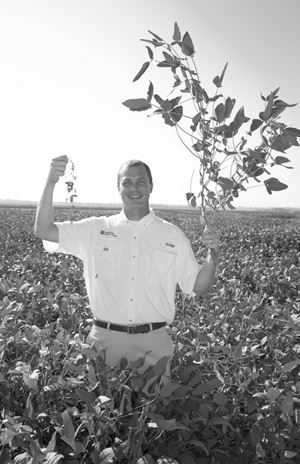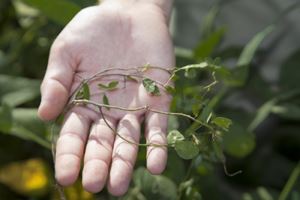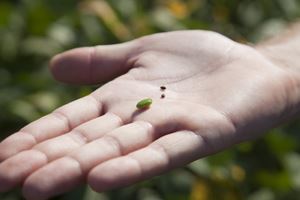Tiny Seed Holds Twice The Diversity
Searching For Novel Genes In Wild Soybean
REGINA LAROSE
MidAmerica Farmer Grower
PORTAGEVILLE, MO.
Senior Research Scientist, University of Missouri-Columbia, Dr. Andrew Scaboo is working with wild soybean looking to advance yield potential by tapping into wild soybean genetics. According to Scaboo, 10,000 years ago today’s soybean did not exist. Growers had wild soybean.



Dr. Scaboo explains the smaller pods and the seeds being about the tenth of the size of modern soybeans makes it extremely tedious working with wild soybean
Photos by John LaRose, Jr.
“Through selection by early farmers for desirable traits, and through breeding we developed the modern day soybean Glycine max. Wild soybean is Glycine soja. Our project is involved in discovering novel genes still left in wild soybean that were selected against when we created Glycine max,” said Scaboo.
Using the USDA collection of over 1,300 Glycine soja varieties, Scaboo and a multi-institutional team of scientist from across the nation, will transfer desirable traits to domesticated soybean. “It is extremely tedious working with wild soybean. The pods are much smaller. The seeds are about the tenth of the size of the seed of modern soybean. The main genes that we are looking for are involved in disease resistance, drought tolerance, seed compositional traits and yield. Previous research has shown that there have been soybean cyst nematode resistance genes that are not found in the domesticated soybean but they are found in the wild soybean.”
Scaboo and scientists at the USDA in North Carolina, Illinois and Maryland have developed a program to transfer 35 different wild soybean types into Glycine max types by growing large population sizes. At Columbia and at the Delta Research Center, Scaboo has wild soybeans and hybrid soybeans growing. “We have populations of over 100,000 plants. We are going into those populations and selecting plants which look like what soybean farmers grow today. The next part of our project is to evaluate all the promising traits that are involved in this wild soybean. This year we have over 80 different varieties of wild soybean growing in Columbia. We will harvest the seed for those. The seed will be measured for protein, oil, fatty acid composition and carbohydrates.”
Scaboo is also evaluating drought tolerance and flood tolerance in the original wild soybean in order to determine which populations to work on. “Our last objective is to evaluate the most efficient way of developing these lines. When you make this cross, you are going to have a lot of deleterious genes. We don’t want our soybean to look like wild soybean. That is why we are growing large population sizes and selecting for plants that look like modern soybean within 100,000 plants.”
“In wild soybean there is more than twice the amount of genetic diversity than in cultivated soybeans. The only way for us to make advances in yield potential through diverse genetics is to tap into the wild soybean genetics,” said Scaboo.∆
REGINA LAROSE: Associate Editor, MidAmerica Farmer Grower